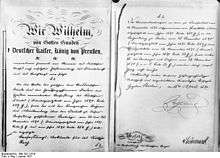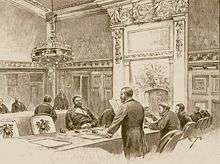Constitution of the German Empire


The Constitution of the German Empire (German: Verfassung des Deutschen Reiches) was the basic law of the German Empire of 1871-1919, enacted 16 April 1871.[1] German historians often refer to it as Bismarck's imperial constitution, in German the Bismarcksche Reichsverfassung.
The constitution was effectively a treaty between its signatories, the North German Confederation and the four German states south of the River Main, [1] adding those states as members of the confederation and giving the enlarged entity a new identity as the Deutsches Reich (conventionally translated as "German Empire"). The Austro-Prussian War of 1866 had resulted in the dissolution of the German Confederation in 1866 and formation of the North German Confederation in 1867, among other events.
The document was essentially an amended version of the North German Constitution, which had likewise been instigated by Otto von Bismarck.
According to the constitution, the empire was a confederation headed by the King of Prussia, who had the title of German Emperor. The Emperor appointed the Chancellor, the head of government and president of the Bundesrat, the council of representatives of the German states. . Laws were enacted by the Bundesrat and the Reichstag, the Imperial Diet elected by male Germans above the age of 25 years.
The constitution has the same German title as its successor, the Weimar Constitution (also known as the "Constitution of the German Reich"), which replaced it in 1919 creating the Weimar Republic.
Signatories and members
The constitution was signed by William I, the King of Prussia, acting in his capacity as President of the North German Confederation, the Kings of Bavaria, Saxony and Württemberg, and the Grand Dukes of Baden and Hesse. Hesse north of the river Main was already a member of the North German Confederation; its territory south of the river was now included as well.
The members of the North German Confederation that now became members of the Empire were Prussia, Mecklenburg-Schwerin, Saxe-Weimar-Eisenach, Mecklenburg-Strelitz, Oldenburg, Brunswick, Saxe-Meiningen, Saxe-Altenburg, Saxe-Coburg-Gotha, Anhalt, Schwarzburg-Rudolstadt, Schwarzburg-Sondershausen, Waldeck, Reuss (older line), Reuss (younger line), Schaumburg-Lippe, Lippe, Lübeck, Bremen, and Hamburg.
The emperor

The empire was officially defined as a confederation of the member states under the presidency of Prussia. The King of Prussia was named in the constitution as "President of the Confederation," and given the title of German Emperor (Deutscher Kaiser). Therefore, the imperial crown was tied to the office of the King of Prussia instead of a personal union between the Empire and Prussia. This meant that, contrary to what Wilhelm II believed at the end of World War I, he could not abdicate merely as German Emperor while keeping the Prussian crown unless he agreed to renounce the entire constitution, which would have been, in effect, the de jure dissolution of the Empire.
Article 11 stated that the emperor had the power to declare war (and make peace), represent the Empire abroad, conclude treaties and alliances, and accredit and receive ambassadors. In the case of a non-defensive war being declared, consent of the Bundesrat was required. Both chambers of parliament had to approve a treaty for it to be ratified.
The emperor also appointed the chancellor.
He had other powers:
- To convene the Bundesrat and the Reichstag (Article 12); the convocation of the Bundesrat was required to take place as soon as demanded by one-third of its members (Article 14).
- To prepare and publish Imperial laws (Article 17).
- To appoint Imperial officials (Article 18).
Legislation
Imperial laws were enacted, with the simple majority, by both the Reichstag (parliament) and the Bundesrat (Article 5). These laws took precedence over the laws of the individual states (Article 2).
Article 13 required the annual convocation of both bodies. The Bundesrat could be called together for the preparation of business without the Reichstag, but not the converse.
The Bundesrat

The Bundesrat (Articles 6 and 7) was made up of representatives of the various states. In German constitutional law, it was not considered a parliament chamber, but foreign commentators tended to reckon it as an upper house. It can be translated to English as Federal Council.
Each state was allocated a specified number of votes; although a state could appoint as many delegates to the Bundesrat as it had votes, the delegates from each state voted as a bloc. Each state had a different number of representatives, with the larger and more powerful states having more. Voting had to be in person, and representatives were bound by the instructions of their state governments.
In the case of legislation affecting only certain states, only those states were allowed to vote.
The Bundesrat's presiding officer could break ties.
A representative could not be a member of both chambers at the same time (Article 9), and was given Imperial protection (Article 10).
The apportionment of the Bundesrat in 1871–1919 was:
State |
Notes |
Votes |
| Prussia | (including states annexed in 1866) |
17 |
| Bavaria | 6 | |
| Saxony | 4 | |
| Württemberg | 4 | |
| Baden | 3 | |
| Hesse | 3 | |
| Mecklenburg-Schwerin | 2 | |
| Brunswick | 2 | |
| 17 other small states | each with 1 vote |
17 |
| Alsace-Lorraine | after 1911 |
3 |
| Total | 61 |
Permanent committees of the Bundesrat
The constitution established permanent committees (Article 8):
- The army, including fortifications
- Naval matters
- Duties and taxation
- Commerce and trade
- The railways, post, and telegraphs
- Justice
- Finance
At least four states had to be represented on each committee, excluding the chairman. Each state was allowed one vote.
On the committee for the army and fortifications, Bavaria had a permanent seat. All of that committee's members were appointed by the Emperor; members of all the other committees were elected by the Bundesrat.
Additionally, there was created a Committee on Foreign Affairs, chaired by Bavaria, with individual members representing Bavaria, Saxony, and Württemberg, and two other members representing the other states.
The Reichstag

Membership of the parliament, the Reichstag or Imperial Diet, was by universal suffrage (this was interpreted to mean suffrage for all male citizens over 25). A secret ballot was guaranteed (Article 20).
Transitional arrangements set the total number of deputies at 382, with 48 for Bavaria, 17 for Württemberg, 14 for Baden, and 6 for Hesse south of the river Main (Article 20).
Bills would be laid before the Reichstag in the name of the emperor, in accordance with a resolution of the Bundesrat, and would be advocated by members of the Bundesrat (or by special commissioners appointed by it)(Article 16).
Imperial legislative powers
Article 4 detailed the areas for which the Empire was responsible for, or was entitled to legislate on:
- Business activity
- Matters concerning natives of one state who were resident in another
- Citizenship
- Surveillance of foreign individuals and businesses
- The issuing of passports
- Insurance business (with some exceptions for Bavaria)
- Colonial activity
- Emigration
- Administration of imperial revenue
- Regulation of weights and measures
- Coinage and the issuing of paper money
- Banking
- Intellectual property
- Protection of German trade and shipping outside of the country
- Consular representation abroad
- Railways (with some exceptions for Bavaria)
- Road and canal construction for means of national defence
- Management of inter-state shipping
- Post and telegraphic services (with some exceptions for Bavaria and Württemberg)
- Authentication of public documents
- Civil law, including its administration
- Criminal law, including its administration
- The Imperial Army and Navy
- Supervision of the medical and veterinary professions.
- Press
- Trade unions
The Reichskanzler (Imperial Chancellor)
The Chancellor of the Empire (Reichskanzler) was appointed by the Emperor, to whom he was solely responsible. He presided over the Bundesrat, and supervised the conduct of its business. The Chancellor had the right to delegate the power to represent him to any member of the Bundesrat. (Article 15)
Decrees and ordinances of the Emperor required the counter-signature of the Chancellor to be valid (Article 17).
On paper, the Chancellor was a one-man cabinet. In practice, however, the Secretaries of State functioned much like ministers in other monarchies.
Citizenship
A single German citizenship was created, with equal treatment of citizens within each state guaranteed (Article 3). However, until 1913, a person would hold the citizenship of the Empire as a result of holding the citizenship of one of the States. Therefore, initially, the criteria for becoming a citizen (the rules of acquisition of citizenship by descent, birth or naturalization), were laid down by the separate laws of the individual States. Only on On 22 July 1913, a common uniform Nationality Law for all the Empire - the Nationality Law of the German Empire and States (Reichs- und Staatsangehörigkeitsgesetz, shorthand: RuStAG) - was adopted.
Imperial officials
Formally, imperial officials were appointed and dismissed by the Emperor. They were required to take an oath of allegiance. Imperial officials appointed from one of the states were guaranteed the same rights as given them by their native state. (Article 18)
Amendments
The constitution was amended on 20 December 1873 by the Lex Miquel-Lasker to make the entirety of civil law the responsibility of the Empire. However, it took some two decades before a national civil code was finally promulgated (as the Bürgerliches Gesetzbuch).
The constitution was heavily amended in the waning days of World War I. The amended document, known as the Oktoberverfassung ("October Constitution") was debated and passed by the Reichstag in late October 1918. The most important changes were:
- Declarations of war and peace treaties now required the assent of the Reichstag
- Members of the government could now simultaneously be members of the Reichstag
- The Reichskanzler and the Secretaries of State now required the confidence of the Reichstag. They were accountable for the conduct of their affairs to the Reichstag and to the Bundesrat
- The Reichskanzler was now responsible for all political actions of the Emperor
- The Emperor's rights to appoint, promote or reassign military officers were now limited by requiring the co-signature of the Reichskanzler or the Minister of War responsible for the contingent. The Ministers of War were now accountable to the Bundesrat and Reichstag for the management of their contingent
The changes came into force on 28 October, transforming the authoritarian Empire into a parliamentary democratic monarchy on the British model.[2][3]:6
However, one month later, with the defeat of Germany in World War I and the November Revolution, the monarchy ceased to exist and the Constitution technically became obsolete.
It formally remained in force, though, and was only changed on 10 February 1919 by the Gesetz über die vorläufige Reichsgewalt passed by the National Assembly. In fact, the Übergangsgesetz of 4 March stipulated explicitly that the 1871 constitution was still valid unless in contradiction to laws passed since November 1918. A new constitution, completely replacing the Imperial one, came into force in the Reich only on 14 August 1919.[4][5]
References
- 1 2 Hayes 1916, p. 397.
- ↑ "Gesetz zur Abänderung der Reichsverfassung 28. Oktober 1918 (Original text of the law, German)". Deutsches Historisches Museum. Retrieved 9 August 2013.
- ↑ Sturm, Reinhard (2011). "Weimarer Republik, Informationen zur politischen Bildung, Nr. 261 (German)". Bonn: Bundeszentrale für politische Bildung. ISSN 0046-9408. Retrieved 9 August 2013.
- ↑ "Chronologie 1919 (German)". Deutsches Historisches Museum. Retrieved 23 July 2013.
- ↑ "Files of the Reichskanzlei: Kabinett Scheidemann, Einleitung II (German)". Bundesarchiv. Retrieved 23 July 2013.
Bibliography
- Hayes, Carlton Joseph Huntley (1916). A Political And Social History Of Modern Europe 1. New York: Macmillan Company.
External links
| Wikisource has original text related to this article: |
- (German) Act concerning the constitution of the German Empire (Constitution of the German Empire of 16 April 1871, in full text)
| ||||||||